NJBillK
Custom Leather and Fixed Blade modifications.
- Joined
- Mar 27, 2014
- Messages
- 9,594
I wanted to see what my 4V EDC would look like after it had some contact with a decent amount of raw protein as well as some spices and fresh herbs.
- Overall usage
A days work was about 18 cases of pork, which after two weeks was about 2,000' of pork butt. The chicken was boneless thighs and chicken trim that wasn't cut by me. Though total chicken was about 40' of poultry. Sausage spice; fennel, salt, pepper (and more), as well as fresh parsley and basil.
- Daily breakdown
The knife would sit wet for the morning, and I would wash the entire knife, dry the exterior of the handle and the blade prior to lunch. Once I was back at it, it would sit wet for the next 3-4 hours. As you can see, the blade has undergone only some slight changes in coloration, with only slight patina to speak of.

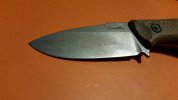
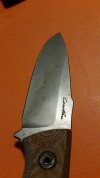
- Unspeakable Horrors lie beneath.
Under the slabs, which I wasn't able to dry, grew a common enemy, red rust and some Very slight pitting...

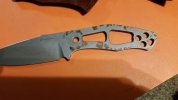
- Corrective Measures
After some elbow grease, a piece of leather, some mildly abrasive compound (steel car rim polishing compound) and about 10 minutes, I had some promising results.
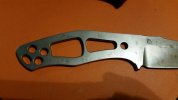
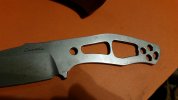
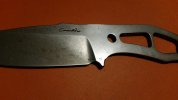
- Conclusion
After the amount of moisture that the knife was subjected to, I was expecting worse on the blade, and under the slabs was just about expected. The knife is going back to work with me tomorrow, and it will stay on my hip for as long as I can manage.
I love the knife and the steel. Maintenance is easy, though I will be more thorough from here on out.
-----
The edge held up nicely. A toothy working edge (DMT Medium) would last easily until lunch without significant noticed degradation and by the end of the day would have me stropping on cardboard or hitting a steel twice. A higher polished edge (DMT EEF), would last until lunch with needing a quick cardboard strop once or twice, then two or three times on a steel/cardboard to get me to the end of the day.
Don't take my comments as meaning the edge was "dull", it would still cut fine, working edge, but fine. I am just Very particular about my edges, so I tend to be a bit fanatical when it comes to feedback from my knifes edge.
Thanks Nathan, Jo, Mark, Lorien, @MikeKu825 and everyone that makes these knives a possibility.
Edit: added Mike to the list. Thanks for allowing me to get my grubby mitts on one!
Second edit: added edge retention info.
- Overall usage
A days work was about 18 cases of pork, which after two weeks was about 2,000' of pork butt. The chicken was boneless thighs and chicken trim that wasn't cut by me. Though total chicken was about 40' of poultry. Sausage spice; fennel, salt, pepper (and more), as well as fresh parsley and basil.
- Daily breakdown
The knife would sit wet for the morning, and I would wash the entire knife, dry the exterior of the handle and the blade prior to lunch. Once I was back at it, it would sit wet for the next 3-4 hours. As you can see, the blade has undergone only some slight changes in coloration, with only slight patina to speak of.



- Unspeakable Horrors lie beneath.
Under the slabs, which I wasn't able to dry, grew a common enemy, red rust and some Very slight pitting...


- Corrective Measures
After some elbow grease, a piece of leather, some mildly abrasive compound (steel car rim polishing compound) and about 10 minutes, I had some promising results.



- Conclusion
After the amount of moisture that the knife was subjected to, I was expecting worse on the blade, and under the slabs was just about expected. The knife is going back to work with me tomorrow, and it will stay on my hip for as long as I can manage.
I love the knife and the steel. Maintenance is easy, though I will be more thorough from here on out.
-----
Ah yes, I forgot to add those little details...But how did it cut/perform/retain the edge? How do you touch up the edge....or even need to?
The edge held up nicely. A toothy working edge (DMT Medium) would last easily until lunch without significant noticed degradation and by the end of the day would have me stropping on cardboard or hitting a steel twice. A higher polished edge (DMT EEF), would last until lunch with needing a quick cardboard strop once or twice, then two or three times on a steel/cardboard to get me to the end of the day.
Don't take my comments as meaning the edge was "dull", it would still cut fine, working edge, but fine. I am just Very particular about my edges, so I tend to be a bit fanatical when it comes to feedback from my knifes edge.
Thanks Nathan, Jo, Mark, Lorien, @MikeKu825 and everyone that makes these knives a possibility.
Edit: added Mike to the list. Thanks for allowing me to get my grubby mitts on one!
Second edit: added edge retention info.
Last edited:


